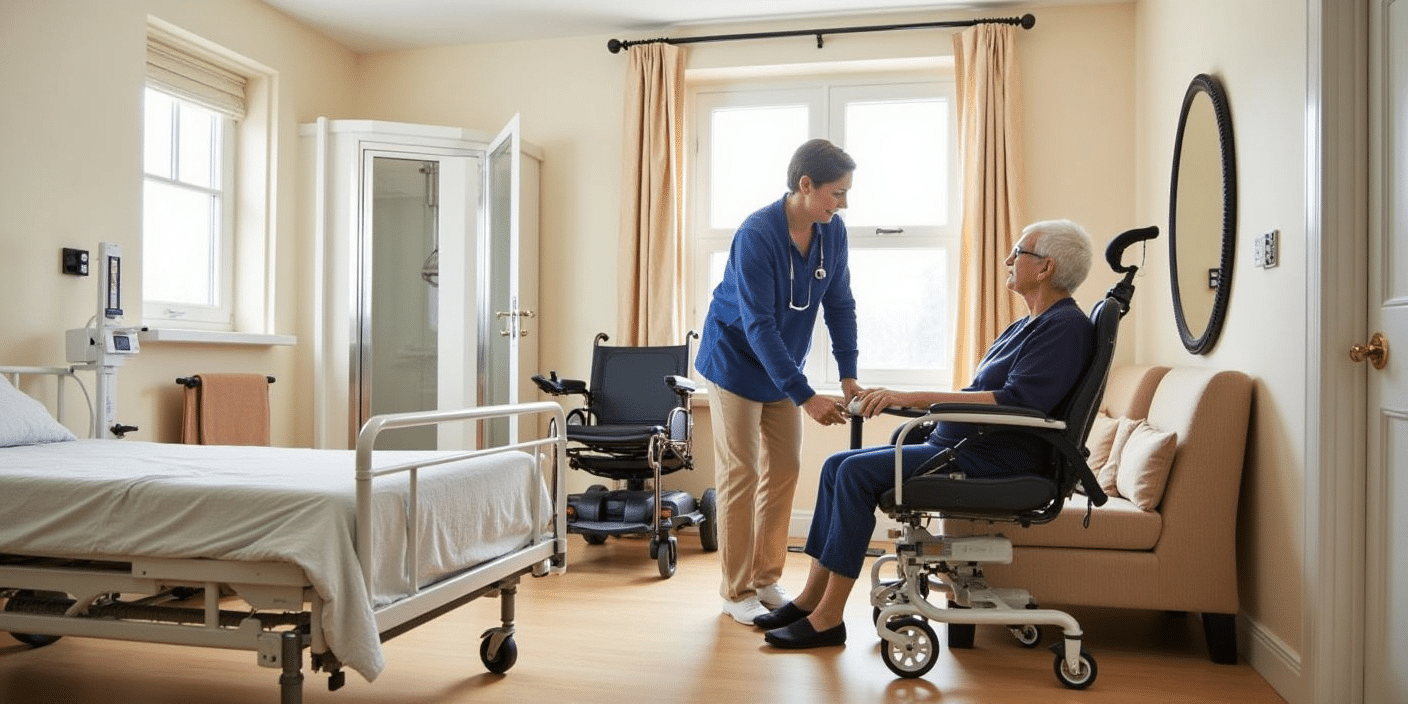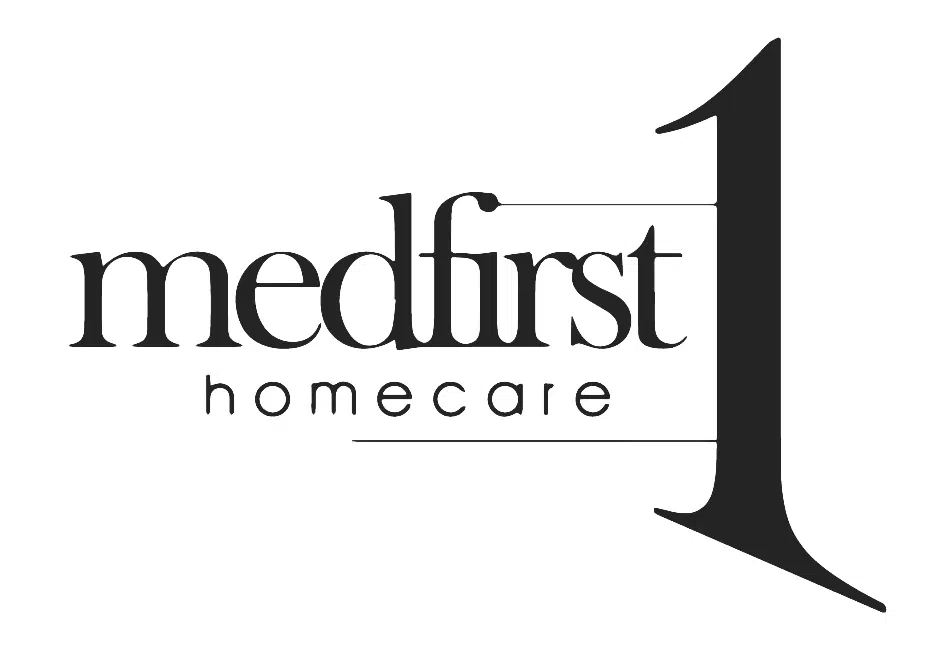
10 Essential Home Medical Equipment
- —

MedFirst Homecare provides high-quality home medical equipment to enhance comfort and independence. From mobility aids to hospital beds and lift chairs, we offer reliable solutions to support daily living. Whether for recovery, long-term care, or added convenience, our products help you or your loved ones maintain dignity and ease at home.
What Medical Supplies Are Needed for Home Care?
Setting up a home hospital care environment requires the right medical supplies to ensure comfort, safety, and proper treatment. Here’s a detailed guide to essential medical equipment:
Hospital Beds & Accessories
- Adjustable hospital beds allow patients to find comfortable positions, improving circulation, reducing pressure sores, and aiding caregivers in repositioning without strain.
- Overbed tables provide an accessible surface for meals, medications, and personal items, reducing unnecessary movement and increasing convenience.
- Bed rails enhance safety by preventing falls and assisting patients in repositioning or getting in and out of bed independently.
- Bed pads and pressure-relief mattresses help prevent pressure injuries, a common concern for patients with limited mobility.
Mobility Aids
- Wheelchairs (manual and power) provide independence for individuals with mobility impairments, allowing them to move freely inside and outside the home.
- Mobility scooters offer an alternative for those who need assistance covering longer distances without fatigue.
- Walkers and rollators support balance and provide stability for individuals who require assistance walking.
- Canes and crutches are ideal for those needing additional support and balance while standing or walking.
Lifting & Transfer Aids
- Patient lifts assist caregivers in safely transferring individuals from bed to chair or other areas, reducing strain and preventing injuries. Available in manual, hydraulic, and electric models, the right type depends on the user’s mobility needs.
- Transfer boards and gait/transfer belts facilitate smoother movement between surfaces, enhancing safety for both patients and caregivers.
- Floor-to-ceiling poles and grab bars offer stability, promoting safer and more independent movement at home.
Bathroom Safety Equipment
- Shower chairs and transfer benches offer secure seating for individuals with limited mobility, reducing fall risks during bathing.
- Raised toilet seats and commodes improve accessibility, making toileting safer and easier for those with mobility challenges.
- Grab bars offer extra support when standing up from the toilet or stepping into a shower or over a tub, helping to prevent slips and falls in the bathroom.
Daily Living Aids
- Adjustable tables and chairs make dining and other activities more comfortable for individuals with limited mobility.
- Bed / couch elevators – few inches can assist with standing
- Reachers and dressing aids assist those who have difficulty bending or stretching, promoting greater independence in daily tasks.
- Adaptive utensils and drinking aids help individuals with limited hand mobility eat and drink more easily, reducing spills and frustration.
Wound Care & Monitoring Equipment
- Blood pressure monitors allow for regular at-home health tracking, helping individuals manage hypertension and cardiovascular conditions.
- Glucose monitors provide essential readings for diabetics to maintain stable blood sugar levels.
- Wound dressings, gauze, and first aid supplies help effectively manage cuts, wounds, and pressure sores at home.
Specialized Seating & Positioning
- Geri chairs provide extended comfort for individuals who are unable to sit in a traditional wheelchair.
- Tilt in space wheelchairs
- Specialty rehab wheelchairs- custom backrest and seating, very adjustable and customizable
- Solid seat inserts promote proper posture and alignment, especially for wheelchair users.
- Pressure-relief cushions are designed to distribute weight evenly, helping to reduce the risk of pressure ulcers and enhance overall seating comfort.
Importance of Home Medical Equipment:
Home medical equipment plays a crucial role in maintaining health, mobility, and independence for individuals with medical conditions or disabilities. It ensures that patients receive proper care in a familiar and comfortable environment, reducing the need for prolonged hospital stays. These devices also provide essential support for caregivers, making daily care tasks easier and safer. From mobility aids to respiratory care, home medical equipment enhances the quality of life for both patients and caregivers, promoting comfort, safety, and dignity.
Explore our customer testimonials
Check all our customer reviews here.
What is home medical equipment?
Home medical equipment includes devices designed to assist individuals with medical needs at home. These include hospital beds, mobility aids, respiratory care products, and daily living aids.
Who can benefit from home medical equipment?
Individuals with disabilities, chronic illnesses, recovering from surgery, or those needing mobility support can greatly benefit from home medical equipment.
How do I choose the right medical equipment for my needs?
Consider factors such as medical condition, mobility level, home space, and doctor recommendations when selecting equipment.
Does insurance cover home medical equipment?
Many insurance plans, including Medicare and Medicaid, cover specific home medical equipment with a doctor’s prescription.
What types of mobility aids are available?
Mobility aids include wheelchairs, power chairs, walkers, rollators, canes, and mobility scooters to assist with movement.
How do I maintain and clean my medical equipment?
Regularly clean equipment with manufacturer-recommended solutions, check for wear and tear, and follow usage guidelines.
What is the difference between a manual and power wheelchair?
Manual wheelchairs require physical effort to propel, while power wheelchairs use a motor and joystick for movement.
How do hospital beds improve patient comfort?
Adjustable positions help with circulation, respiratory support, and ease of movement for both patients and caregivers.
Can I rent medical equipment instead of purchasing it?
Yes, many suppliers, including MedFirst Homecare, offer rental options for short-term medical needs.
What is the best way to ensure home safety for someone with mobility issues?
Install grab bars, use non-slip mats, and ensure clear walkways to prevent falls and accidents.
How do I know if a mobility scooter is right for me?
Consider mobility limitations, daily activity level, and the terrain where you’ll be using the scooter.
What is the importance of pressure-relief cushions?
They help prevent pressure sores and provide comfort for individuals who spend extended periods in wheelchairs or beds.
How do grab bars and floor-to-ceiling poles help with independence?
These aids provide stability and support when moving between different areas of the home.
Where can I find instructions for using my equipment safely?
Each product comes with a user manual, and MedFirst Homecare provides additional support if needed.
Do you offer local delivery for home medical equipment?
Yes, MedFirst Homecare provides delivery services in select areas of New Jersey and New York. Check your zone here
